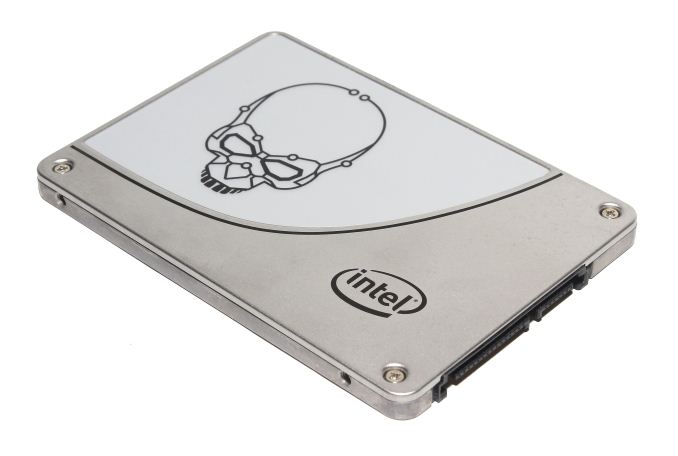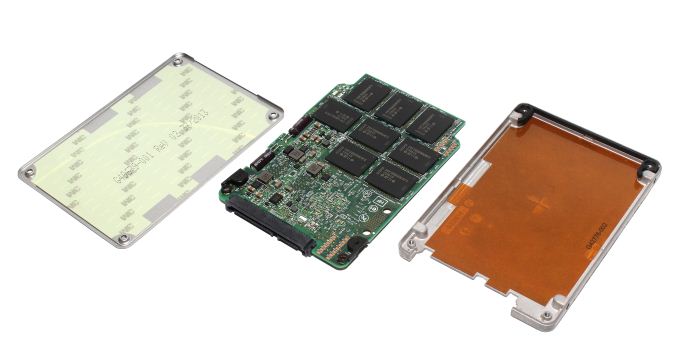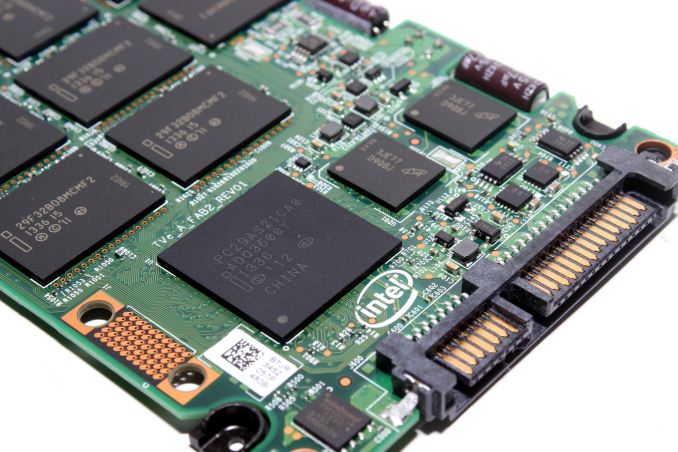Intel SSD 730 (480GB) Review: Bringing Enterprise to the Consumers
by Kristian Vättö on February 27, 2014 12:00 PM EST- Posted in
- Storage
- SSDs
- Intel
- Intel SSD 730

The days of Intel being the dominant player in the client SSD business are long gone. A few years ago Intel shifted its focus from the client SSDs to the more profitable and hence alluring enterprise market. As a result of the move to SandForce silicon, Intel's client SSD lineup became more generic and lost the Intel vibe of the X-25M series. While Intel still did its own thorough validation to ensure the same quality as with its fully in-house designed drives, the second generation SandForce platform didn't allow much OEM customization, which is why the SSD 520 and other SandForce based Intel SSDs turned out to be very similar to the dozens of other SandForce driven SSDs in the market.
The SSD market has matured since the X-25M days and a part of the maturing process involves giving up profits. Back in 2007-2008 the SSD market (both client and enterprise) was a niche with low volume and high profits, so it made sense for Intel to invest in custom client-oriented silicon. There wasn't much competition and given Intel's resources and know-how, they were able to build a drive that was significantly better than the other offerings.
The high profits, however, attracted many other manufacturers as well and in the next few years Intel faced a situation it didn't like: profit margins were going down, yet bigger and bigger investments had to be made in order to stay competitive in the client market. OCZ in particular was heavily undercutting Intel's pricing and big companies with technological and scale advantage like Intel tend not to like the bargain game because at the end of the day it's not as profitable for them. The enterprise market is a bit different in this regard because price is not usually the commanding factor; instead the focus is on reliability, features and performance, which made it an easy choice for Intel to concentrate its resources on covering that market instead.
For the majority of consumers this change in focus was negligible since the likes of Micron and Samsung had started paying attention to the retail consumer SSD market and Intel was no longer the only good option available. However, enthusiasts were left yearning for an Intel SATA 6Gbps design as many had built brand loyalty for Intel with the X-25M. In late 2012 the wishes materialized but to their disappointment only in the form of an enterprise SSD: the DC S3700. This verified that enterprise was Intel's first priority but given that it was a SATA 6Gbps rather than a PCIe design, it left hope for a more client-orientated in-house Intel solution. Fast-forward to today and that solution is now here. Please meet the SSD 730, Intel's new client flagship.
Adopting the platform from the DC S3500/S3700, the SSD 730 is Intel's first fully in-house designed client drive since the SSD 320. The SSD 730 is not just a rebranded enterprise drive, though, as both the controller and NAND interface are running at higher frequencies for increased peak performance. While the branding suggests that this is an enterprise drive like the SSD 710, Intel is marketing the SSD 730 directly to consumers and the DC S3xxx along with the 900 series remain as Intel's enterprise lineups. And in a nod to enthusiasts, the SSD 730 adopts the Skulltrail logo to further emphasize that we are dealing with some serious hardware here.
| Capacity | 240GB | 480GB |
| Controller | Intel 3rd Generation (SATA 6Gbps) | |
| NAND | Intel 20nm MLC | |
| Sequential Read | 550MB/s | 550MB/s |
| Sequential Write | 270MB/s | 470MB/s |
| 4K Random Read | 86K IOPS | 89K IOPS |
| 4K Random Write | 56K IOPS | 74K IO |
| Power (idle/load) | 1.5W / 3.8W | 1.5W / 5.5W |
| Endurance | 50GB/day (91TB total) | 70GB/day (128TB total) |
| Warranty | Five years | |
| Availability | Pre-orders February 27th - Shipping March 18th | |
Intel is serious about the SSD 730 being an enterprise-class drive for the client market as even the NAND is pulled from the same batch as Intel's MLC-HET NAND used in the S3700 and the endurance rating is based on JEDEC's enterprise workload. JEDEC's SSD spec, however, requires that client SSDs must have a data retention time of one year minimum whereas enterprise drives must be rated at only three months, which gives the S3500/S3700 a higher endurance. MLC-HET also trades performance for endurance by using lower programming voltages, resulting in less stress on the silicon oxide.
| Intel SSD 730 | Intel SSD 530 | Intel SSD DC S3500 | Intel SSD DC S3700 | |
| Capacities (GB) | 240, 480 | 80, 120, 180, 240, 360, 480 | 80, 120, 160, 240, 300, 400, 480, 600, 800 | 100, 200, 400, 800 |
| NAND | 20nm MLC | 20nm MLC | 20nm MLC | 25nm MLC-HET |
| Max Sequential Performance (Reads/Writes) | 550 / 470 MBps | 540 / 490 MBps | 500 / 450 MBps | 500 / 460 MBps |
| Max Random Performance (Reads/Writes) | 89K / 75K IOPS | 48K / 80K IOPS | 75K / 11.5K IOPS | 76K / 36K IOPS |
| Endurance (TBW) |
91TB (240GB) 128TB (480GB) |
36.5TB |
140TB (200GB) 275TB (480GB) |
3.65PB (200GB) 7.3PB (400GB) |
| Encryption | - | AES-256 | AES-256 | AES-256 |
| Power-loss Protection | Yes | No | Yes | Yes |
Continuing with the enterprise features, there is full power-loss protection similar to what's in the S3500/S3700. I'm surprised that we've seen so few client SSDs with power-loss protection. Given the recent studies of power-loss bricking SSDs, power-loss protection should make a good feature at least in the high-end SSDs.
Test System
| CPU |
Intel Core i5-2500K running at 3.3GHz (Turbo and EIST enabled) |
| Motherboard | AsRock Z68 Pro3 |
| Chipset | Intel Z68 |
| Chipset Drivers | Intel 9.1.1.1015 + Intel RST 10.2 |
| Memory | G.Skill RipjawsX DDR3-1600 4 x 8GB (9-9-9-24) |
| Video Card |
Palit GeForce GTX 770 JetStream 2GB GDDR5 (1150MHz core clock; 3505MHz GDDR5 effective) |
| Video Drivers | NVIDIA GeForce 332.21 WHQL |
| Desktop Resolution | 1920 x 1080 |
| OS | Windows 7 x64 |
Thanks to G.Skill for the RipjawsX 32GB DDR3 DRAM kit












96 Comments
View All Comments
gevorg - Thursday, February 27, 2014 - link
Whats up with the satanic skull? LOL!DanNeely - Thursday, February 27, 2014 - link
The tacky gamer bling is intended to convince corporate purchasing to buy the more expensive S3500 instead.littlebitstrouds - Thursday, February 27, 2014 - link
Well aren't you mean today. Just because it doesn't fit your style, doesn't mean you need to be a jerk about it.Homeles - Friday, February 28, 2014 - link
I thought it was funny!alyarb - Friday, February 28, 2014 - link
and insightful! it's not like you saw skulltrail boards in 2P workstations either. you have to pay extra to get the plain green board.ddriver - Friday, February 28, 2014 - link
This hard drive is poisonous.tabascosauz - Saturday, March 1, 2014 - link
It's probably like the skull on Intel's motherboards; just a logo that's been there for so long that it's become an icon of Intel in the consumer market. I still like the old peel-up-for-silicon Intel design on my SSD 530 though, but not that it matters since there's only one case that showcases SSDs (H440).Anonymous Blowhard - Friday, February 28, 2014 - link
sarchasm (sar-kaz-im)1. the gulf between the author of sarcastic wit and the person who doesn't get it
DanNeely - Friday, February 28, 2014 - link
I intended describing it as 'tacky gamer bling' as being charitable. If I felt like being mean I'd've used something like 'eye searingly hideous' instead.Oxford Guy - Thursday, March 6, 2014 - link
It's really idiotic.Intel looks like a foolish old man trying to be cool with that.